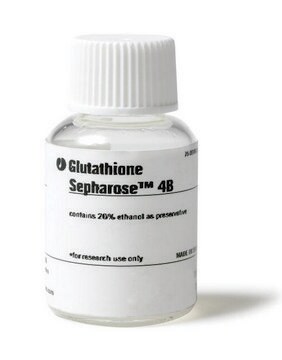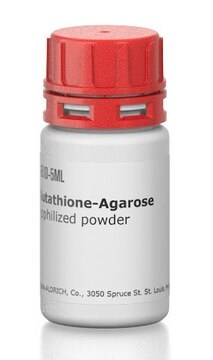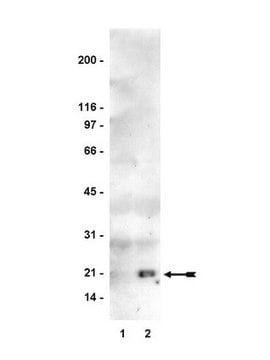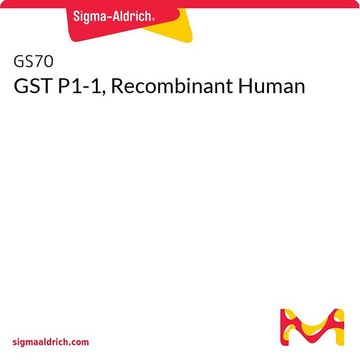SRP5348
GST protein, tag-free
recombinant, expressed in E. coli, ≥70% (SDS-PAGE), buffered aqueous glycerol solution
Iniciar sesiónpara Ver la Fijación de precios por contrato y de la organización
About This Item
Productos recomendados
recombinant
expressed in E. coli
assay
≥70% (SDS-PAGE)
form
buffered aqueous glycerol solution
mol wt
~25 kDa
technique(s)
ligand binding assay: suitable
NCBI accession no.
shipped in
dry ice
storage temp.
−70°C
Gene Information
Escherichia coli IAI39 ... gst> gst
gst(7152360)
General description
Glutathione S-transferase (GST) family of enzymes comprises a long list of cytosolic, mitochondrial and microsomal proteins that are used to create the so-called GST gene fusion system. These proteins are capable of multiple reactions with a multitude of substrates. They have a role in detoxication and toxification mechanisms. GST tag has the size of 220 amino acids, which is relatively large compared to other tags like the myc- or the FLAG-tag that are quite small. GST can be used to purify and detect proteins of interest. In a GST gene fusion system, an expression vector consists of the gene sequence encoding the protein of interest and GST sequence alongside. After induction, the fusion proteins can be purified using affinity chromatography via its high affinity for glutathione.
Application
GST protein, tag-free has been used in in vitro F-actin binding assay. It has also been used as a protein tag for TPX2 (targeting protein for Xklp2).
Physical form
Supplied in 50 mM Tris-HCl, pH 7.5, 150 mM NaCl, 10 mM glutathione, 0.1 mM EDTA, 0.25 mM DTT, 0.1 mM PMSF, 25% glycerol.
Preparation Note
After opening, aliquot into smaller quantities and store at -70 °C. Avoid repeating handling and multiple freeze/thaw cycles.
Storage Class
10 - Combustible liquids
wgk_germany
WGK 1
flash_point_f
Not applicable
flash_point_c
Not applicable
Certificados de análisis (COA)
Busque Certificados de análisis (COA) introduciendo el número de lote del producto. Los números de lote se encuentran en la etiqueta del producto después de las palabras «Lot» o «Batch»
¿Ya tiene este producto?
Encuentre la documentación para los productos que ha comprado recientemente en la Biblioteca de documentos.
Los clientes también vieron
Italia Anna Asteriti et al.
Oncotarget, 8(19), 32117-32133 (2017-04-09)
Aurora kinases are a family of cell division regulators that govern the correct assembly of a bipolar mitotic spindle and the fidelity of chromosome segregation. Their overexpression is associated with genomic instability and aneuploidy, and is frequently observed in cancer.
Cdc42EP3/BORG2 and Septin Network Enables Mechano-transduction and the Emergence of Cancer-Associated Fibroblasts.
Calvo F
Cell Reports, 13(12), 2699-2714 (2015)
Duong Thi Thuy Nguyen et al.
Cell death and differentiation, 24(6), 1063-1078 (2017-04-22)
Rapidity and specificity are characteristic features of proteolysis mediated by the ubiquitin-proteasome system. Therefore, the UPS is ideally suited for the remodeling of the embryonic stem cell proteome during the transition from pluripotent to differentiated states and its inverse, the
Identification of small molecule inhibitors of the Aurora-A/TPX2 complex
Asteriti IA, et al.
Testing, 8(12), 32117-32117 (2017)
Yujing Li et al.
Nature communications, 9(1), 4394-4394 (2018-10-24)
Heterozygous deletion of chromosome 17p (17p) is one of the most frequent genomic events in human cancers. Beyond the tumor suppressor TP53, the POLR2A gene encoding the catalytic subunit of RNA polymerase II (RNAP2) is also included in a ~20-megabase
Nuestro equipo de científicos tiene experiencia en todas las áreas de investigación: Ciencias de la vida, Ciencia de los materiales, Síntesis química, Cromatografía, Analítica y muchas otras.
Póngase en contacto con el Servicio técnico







